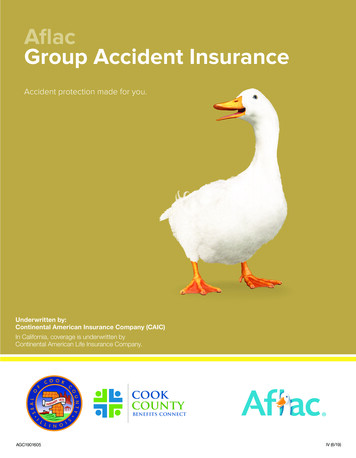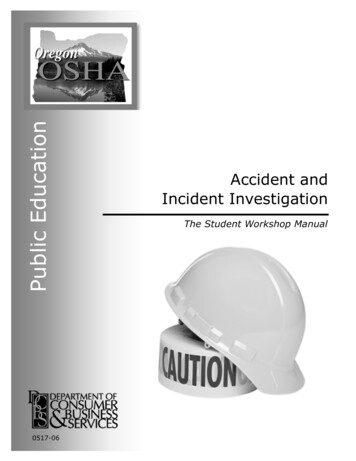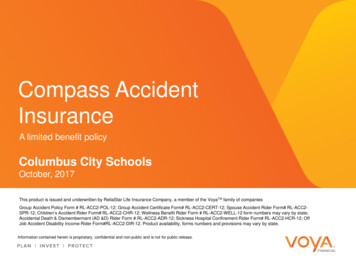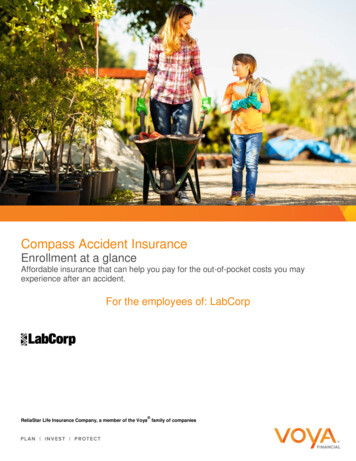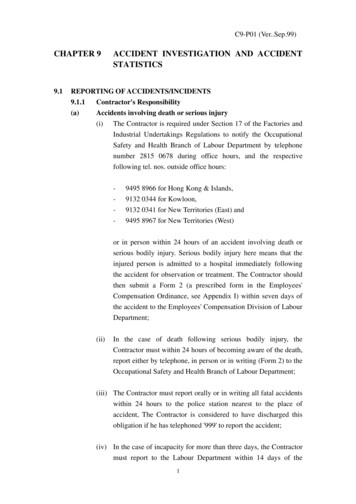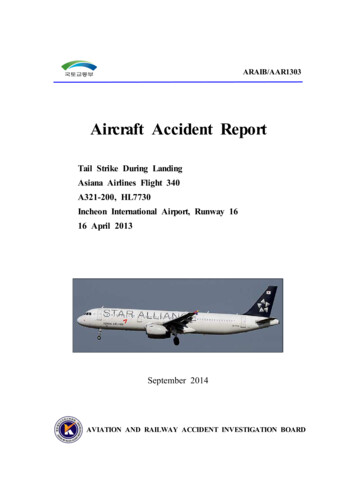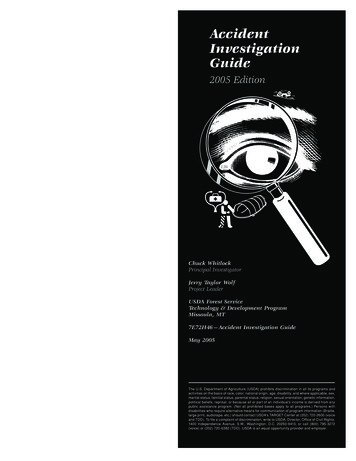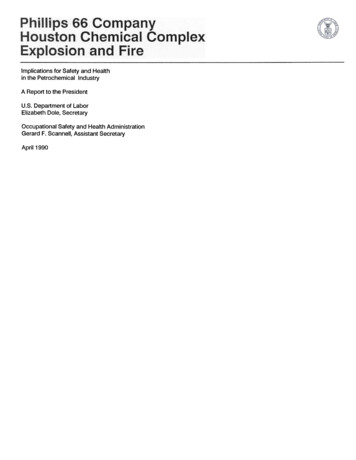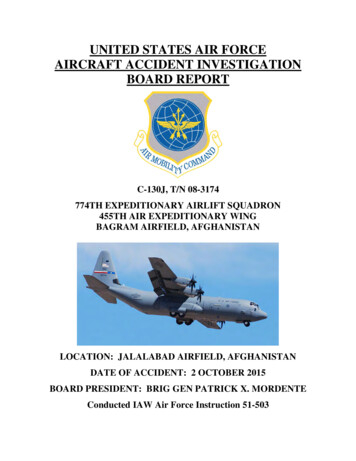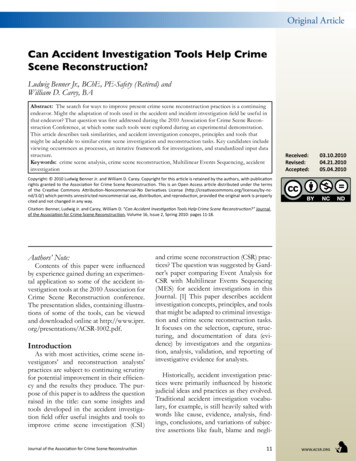
Transcription
ArticleOriginal ArticleOriginal ArticlesCan Accident Investigation Tools Help CrimeScene Reconstruction?Ludwig Benner Jr., BChE, PE-Safety (Retired) and William D. Carey, BAAbstract: The search for ways to improve present crime scene reconstruction practices is a continuingendeavor. Might the adaptation of tools used in the accident and incident investigation field be useful inthat endeavor? That question was first addressed during the 2010 Association for Crime Scene Reconstruction Conference, at which some such tools were explored during an experimental demonstration.This article describes task similarities, and accident investigation concepts, principles and tools thatmight be adaptable to similar crime scene investigation and reconstruction tasks. Key candidates includeviewing occurrences as processes, an iterative framework for investigations, and standardized input datastructure.Keywords: crime scene analysis, crime scene reconstruction, Multilinear Events Sequencing, 10.201004.21.201005.04.2010Copyright: 2010 Ludwig Benner Jr. and William D. Carey. Copyright for this article is retained by the authors, with publicationrights granted to the Association for Crime Scene Reconstruction. This is an Open Access article distributed under the termsof the Creative Commons Attribution-Noncommercial-No Derivatives License (http://creativecommons.org/licenses/by-ncnd/3.0/) which permits unrestricted noncommercial use, distribution, and reproduction, provided the original work is properlycited and not changed in any way.Citation: Benner, Ludwig Jr. and Carey, William D. “Can Accident Investigation Tools Help Crime Scene Reconstruction?” Journalof the Association for Crime Scene Reconstruction, Volume 16, Issue 2, Spring 2010: pages 11-18.Authors’ Note:Contents of this paper were influencedby experience gained during an experimental application so some of the accident investigation tools at the 2010 Association forCrime Scene Reconstruction conference.The presentation slides, containing illustrations of some of the tools, can be viewedand downloaded online at troductionAs with most activities, crime scene investigators’ and reconstruction analysts’practices are subject to continuing scrutinyfor potential improvement in their efficiency and the results they produce. The purpose of this paper is to address the questionraised in the title: can some insights andtools developed in the accident investigation field offer useful insights and tools toimprove crime scene investigation (CSI)Journal of the Association for Crime Scene Reconstructionand crime scene reconstruction (CSR) practices? The question was suggested by Gardner’s paper comparing Event Analysis forCSR with Multilinear Events Sequencing(MES) for accident investigations in thisJournal. [1] This paper describes accidentinvestigation concepts, principles, and toolsthat might be adapted to criminal investigation and crime scene reconstruction tasks.It focuses on the selection, capture, structuring, and documentation of data (evidence) by investigators and the organization, analysis, validation, and reporting ofinvestigative evidence for analysts.Historically, accident investigation practices were primarily influenced by historicjudicial ideas and practices as they evolved.Traditional accident investigation vocabulary, for example, is still heavily salted withwords like cause, evidence, analysis, findings, conclusions, and variations of subjective assertions like fault, blame and negli11www.acsr.org
gence. [2] Ever increasing complexity ofsystems and larger risks have motivated agrowing body of accident investigation research by increasingly diverse disciplines.[3,4,5] Such research challenges much ofthe traditional wisdom and practices, andoffers new investigation concepts, principles, and tools for the accident investigation field. [6] Those new investigation concepts, principles, and tools diverge from thejudicial ideas and practices toward a morescientifically oriented view of accidents andtheir investigation. What are those new developments, and might they benefit criminal investigations and crime scene analysisand reconstruction?Accident InvestigationDevelopmentsDevelopments involve many issues, suchas accident investigation methodologicalimprovement and assessment, [7] accidentinvestigation scope, accident modeling, accident investigation output quality, [8] lessons learned from accident investigation,[9] and accident investigation performancemetrics, [10,11] among others. Methodological tasks and tools seem most directlycomparable to crime scene investigationsand reconstruction, so they will be the primary focus of this analysis. Accident investigation advances have addressed accidentinvestigation tasks and procedures like accident investigation data acquisition; datainterpretation; data documentation, organization, analysis and validation; and reporting of accident investigation findings.The challenges faced by investigatorsof accidents and crimes have many similarities, and some significant differences.Similarities include the fundamental questions of what data to acquire and how bestto analyze the data. Both deal with historical events, have a similar goal of describingand reporting what happened accuratelyand persuasively, have many similar dataidentification and acquisition challenges,and face challenges from parties with different interests. Other similarities couldbe cited, like the status of privileged inforwww.acsr.org12mation and concerns about the “truth” revealed by their work.A major difference is the use to whichtheir respective work products will be put.CSR is used to prepare and present facts forjuries or judges to weigh. Accident investigation outputs are used primarily to determine how to prevent recurrence. The mainfocus of this paper will be on the similartasks and practices.Investigation conceptsSimilarities suggest that several fundamental accident investigation conceptscould be relevant to CSI and CSR. Theyinclude viewing occurrences as processes,iterative framework for investigations, andstandardized input data structure.Occurrences are processes. Both accidentsand crimes are best viewed as “processes.”[12,13] During a process, successive actionsaffect other actions, and change conditionsor states, to produce process outcomes.Thus actions offer a focus for investigationtasks. Traditional views, such as chain ofevents, do not reflect the dynamic realitiesof accidents or crimes observed by investigators and analysts. They must contendwith multiple actions and interactions occurring in sequence and often concurrentlyover time.Framework for investigation. A conceptualframework for investigations drives whatis done. A framework is a basic structurebehind a system. In accident investigation,two structures are involved: the structurefor the facts and for the analysis. Selectionof the structures used by investigators andanalysts is a pivotal decision: they must bemutually compatible and supportive. (SeeFigure 1.)Input data structure. Investigation inputdata or evidence must be structured so itcan be verified as true or untrue. Logicstatements provide a formal common structure for documenting inputs or evidence.Volume 16, Issue 1, Winter 2010
Figure 1: InvestigationBuilding Block Structure.For accident investigation, the main workhorse is the actor/action structure for logicstatements, which produces the buildingblocks (BBs) for the analysis tasks. [14] Investigators and analysts can verify whethereach BB is true or false from the referencedsource data.Think Actor/Action. This helps investigators and analysts to document and workwith logic statements that can be related toeach other to form a verified description ofwhat happened. When viewing the sceneor examining verbal or physical evidence,other principles are:Analysis structure. A practical analysisstructure for the accident investigationanalysis tasks is the multilinear events sequencing (MES) worksheet, using a time/actor matrix to array the logical statementbuilding blocks in their temporal and spatial sequence. [15] The matrix is analogousto the structure of a musical score. Thisstructure provides a workspace that enablesthe analyst to enter, edit and display theorder, relevance, relationship and materiality of each building block used to describewhat happened. When completed and simplified, it provides a road map for readilyunderstanding what happened. (See Figure2.) Track change makers Transform input data into reconstruction building blocks (BBs) Make mental movies of actions Break down BBs as needed to followactions Build worksheets with Time/Actormatrix to sequence BBs Link interdependent BBs Fill gaps on worksheet Remove extraneous BBs and links Draft reports from worksheetsFigure 2: MES MatrixWorksheet Structure. Investigation PrinciplesPrinciples are propositions that serve asa foundation for a chain of reasoning. Anumber of accident investigation principlesseem relevant to crime scene investigationand reconstruction tasks. Accident investigation principles that might provide guidance for CSIs and CSRs include:Journal of the Association for Crime Scene Reconstruction13www.acsr.org
Eleven detailed guides for implementingthese principles [16] are publicly available.Most seem adaptable to crime scene investigation and reconstruction. These principlescan be implemented manually, and theyhave been implemented in software to support accident investigation. An overviewof what the software is and how it works isavailable online. [17]Axioms. Axioms are propositions thatare regarded as being established, accepted,or self-evidently true. Ten accident investigation axioms for improving investigation performance can be found at http://www.iprr.org/admin/Top10Axioms.html.Axioms like, “If you can’t flow chart it, youdon’t understand it” or “No test plan, notest” or “Abstractions cover up poor investigations” for example, would seem applicable to criminal investigations.Investigation ProceduresAccident investigation procedures implementing these concepts and principles seemto have the potential to help CSIs and CSRsdevelop relevant and material descriptionsof crimes.Crime scene analysts depend on inputdata from many sources, so they should beable to specify to each data provider thestructure and other attributes of the input data they need. That varies from caseto case. The sources could include crimescene sketches or maps and measurements,photographs, audio or video recordings,victims injuries or their observations, various kinds of objects, debris or residues, forensic reports, interrogation and interviewstatements, and documents, instrument recordings or historical records, for example.Each case is unique, as are the data sourcesthat need to be pursued. Analysts can identify those sources using MES tools like theactor/action building block worksheets,placeholders, and mental movies. An essential MES BB component is the sourceof the data from which the BB entry is derived. (Figure 1 item 5).www.acsr.org14Create Building Blocks. When examiningthe scene, identify with a unique name thepeople, objects, or energies involved. Thename of the actor, or a placeholder, is always the first entry for any MES buildingblock. This helps to keep investigators andanalysts focused on the needed evidencestructure as they gather the input data anduse it. The most challenging BB entry isthe description of what the actor did, to ensure that others reading it could visualize it.Using words at the lowest level of abstraction and the least ambiguous words helpsto achieve this. A list of “poison words” orambiguous words to avoid is useful becauseambiguous words frustrate logic application and testing.Use placeholders. When entering data, often some part of a BB is not known when itis first created. Use of a “?” as a placeholderin the BB identifies data to be acquired.Once created, all BBs must be organizedto show the sequence in which they occurred. With MES, this is done on a worksheet consisting of a time/actor matrix. Array BBs on the worksheet in sequence assoon as they are acquired. Any “?” indicatesan open data item or uncertainty.Make mental movies. As an MES worksheetgrows, it is helpful for investigators or analysts to try to visualize what happened fromthe wording of the BBs, in the form of a“mental movie.” That step brings to lightgaps in the scenario being developed as difficulties arise with tracking an actor or action, or picturing what an actor did.Break down BBs. If what an actor did can’tbe followed, it may be helpful to breakdown actions into smaller steps to fullydescribe a crime. For a simple example,“suspect fled from scene” might be brokendown into suspect broke bedroom window,climbed out through the window, and soforth, to suggest places to look for moreevidence. In developing circumstantial evidence, a similar technique might be usefulwhen pursuing actions that might provideVolume 16, Issue 1, Winter 2010
motives for a crime, such as developing apattern of actions over time before or aftera murder, and displaying the resulting BBs.Build worksheets. MES matrix worksheetsprovide the workspace to organize the sequence and relationships among the BBs asthey are created. The time and actor coordinates provide for the positioning or repositioning of each BB relative to all others onthe worksheet as it is created, streamlining,and expediting the investigation and reconstruction tasks. See Figure 3 for an exampleof how a worksheet being developed duringan investigation might look. Figure 3 usedsupport software (“Investigation Catalyst”for Macintosh); worksheets can be prepared manually. Color codes can indicateBB attributes. Sequence or durations canbe changed as new data become available.Contents of each BB, including sources,can be viewed in detail when needed. Earlier building blocks for actions identifyingmotives or premeditation would be enteredahead of the actions shown.Link BBs. For accident investigations, thescenario is described and explained by theflow of all the interactions from the beginning until the outcome of interest occurs. Afew links are shown in Figure 3 to indicaterelationships that have been tentatively established thus far.Crime scene analyses would likely evolveas actions provided by forensic examinations are entered along with the actions derived from observed evidence, so the linking of all actions by first on-scene officersmight not be as essential to meet CrimeScene Analysts’ (CSA) objectives.After all available BBs are entered, extraneous BBs can be removed from theworksheet, leaving only those necessaryto satisfy the analyst’s need to describe theperpetrator(s) and victim(s) actions. Thusthe number of rows required to display actions for CSA purposes could be less thanneeded for accident investigation purposes.Journal of the Association for Crime Scene ReconstructionFill gaps on worksheets. During accidentinvestigations, the arraying of BBs oftenshows gaps in the flow of interactions byshowing a BB that either logically or intuitively influenced other actions, but cannotbe linked directly to those actions becausesomething else had to happen betweenthem. Structuring speculations or hypotheses into an “MES Tree” [12] which is a logictree structure bounded on both ends by theknown BBs, provides CSAs a way to bridgethese gaps.Mark uncertainties. MES tools help ensureanalysis credibility. The most important isarraying known data so it tells a persuasivestory of what happened. The BB structuring, arraying, and linking tools help do this,as do the “?” placeholders. It is preferablefor investigators or analysts to identify uncertainties with a ? in BBs or unconfirmedlinks and explain them, rather that haveadversaries undermine their entire work bypointing out one or two minor gaps or uncertainties.Review Worksheet. MES worksheets provide a relatively objective way to assure thequality of an investigation or analysis. Byusing the BB structure criteria and BB linking and sourcing criteria, reviewers can review the quality of the output.Timing of individual actions may not beas critical for CSA as it is for accident investigation, but all the BBs shown on theworksheet would have to accommodate orfit between any time “anchors” defined before, during or after the crime.Print BBs for reports. Sequenced BBs canprovide a useful outline of what happenedfor the preparation of investigators’ andanalysts’ written reports. Either the completed graphic worksheet displays or tabularprintouts of the sequenced BBs can be usedfor that purpose when computer supportis used. This helps ensure that the writtenreport presents the results in a readily assimilable sequence and form for lay users.15www.acsr.org
Figure 3: Worksheet viewduring investigation inprogress.This opportunity is not readily availablewhen worksheets are prepared manually.Investigation Logic ToolsThree kinds of logic tools are used ininvestigations. The first kind is, or shouldbe, logic statements which are statementsthat can be determined to be true or false.Each statement used on the final worksheetshould be found true, based on the sourceevidence from which it is derived. The datastructure in Figure 1 satisfies this tool.The second kind is logical reasoningtools for creating, sequencing, and linkingwww.acsr.org16building blocks.1. Deductive reasoning, used tocreate BBs from knowledge about howto interpret data from evidence suchas debris, observations, interviews, recordings, etc. (evidence or facts).2. Sequential reasoning, used tocreate MES worksheets by positioningBBs on the matrix according to theirtemporal and spatial sequences.3. Input-output or cause-effect reasoning, used to find and link individual actions that were parts of actionVolume 16, Issue 1, Winter 2010
pairs or sets, defining interactions or“behavioral sets” on MES worksheets.ologies, SAE/Special Publication 80/4611980.4. Necessary and sufficient reasoning, used to test individual BBs andarrays of BBs and links on an MESworksheet for completeness and validity.5. C.W. Johnson, Failure in SafetyCritical Systems: A Handbook of Accident and Incident Reporting, University ofGlasgow Press, Glasgow, Scotland, October 2003. ISBN 0-85261-784-4.Logic fallacies are a third kind of logictool used by investigators to error checktheir building block contents. [18] Commonlogic fallacies, like amphibolies, neglectedaspect, or poisoning of the wells, with illustrative examples, can be accessed online.6. Dekker, S., The Field Guide to Understanding Human Error, Ashgate, SurreyUK, 2006.SummaryFrom the above, it appears that criminal investigations and crime scene analysis and reconstruction tasks could benefitby considering crimes to be processes andby adapting selected accident investigationtools for the timely and rigorously structured documentation and ordering of actorsand actions derived from evidence createdduring or relevant to the crime. Referencesare provided for further exploration of thatpossibility by crime scene investigators andreconstruction analysts.References1. Gardner, R. M., A Comparison ofEvent Analysis and Multilinear Events Sequencing Techniques for ReconstructingUnique Phenomena, Journal of the Association for Crime Scene Reconstruction,Volume 16, Issue 1, Winter 2010, pages 1-9.2. Rimson, I.J. Investigating “Causes”,Proceedings of International Society of AirSafety Investigators International Seminar,Barcelona, Spain October 20 1998.3.Benner, L., Accident Theory andAccident Investigation, Proceedings of theSociety of Air Safety Investigators Annual Seminar, Ottawa, Canada 7-9 October,1975.4. Benner, L., Accident Investigations:A Case For New Perceptions And MethodJournal of the Association for Crime Scene Reconstruction7. Harvey, M. D., Models for AccidentInvestigation, Alberta Workers Health,Safety and Compensation, OccupationalHealth and Safety Division, April 1985.8. Hendrick, K.M and Benner, L, Investigating accidents with STEP, MarcelDekker, NY NY 1987.9. European Safety and ReliabilityData Association, 36th Seminar LessonsLearned from Accident Investigations,Coimbra PT June 2nd and 3rd, 2009. TheAssociation established a special WorkingGroup to seek improvements.10. Benner, L., Accident Data for theSemantic Web, ESReDA 33 Seminar, IspraIT, November 2007.11. Benner, L., Rating Accident ModelsAnd Investigation Methodologies, Journalof Safety Research, 16:3, Fall 1985 Chicago,IL.12. Sklet, S., Comparison of some selected methods for accident investigation. JHazard Mater. 2004 Jul 26; 111(1-3): 29-37.13. Benner, L., Accident Investigation:Multilinear Events Sequencing Methods,Journal of Safety Research, 7:2, June 1975.14. Benner, L., 5 Perceptions of theAccident Phenomenon, Journal of SystemSafety, October 2009.15. Starline Software Ltd, Self-Help17www.acsr.org
Learning Resources For Achieving Efficient, Effective And Timely InvestigationsOf All Kinds. 1994 See Guide 1, Figure 4.Available at 0.html16. Ibid. Guide 2.17. Ibid. Guide 318. Starline Software Ltd, Overview isaccessible at: eview.html19. Benner, L. and Ryan, J., Logic andLogic Fallacies, International Society of AirSafety Investigators forum, 1990-1. Available at fwww.acsr.org18Volume 16, Issue 1, Winter 2010
sons learned from accident investigation, [9] and accident investigation performance metrics, [10,11] among others. Method-ological tasks and tools seem most directly comparable to crime scene investigations and reconstruction, so they will be the pri-mary focus of this analysis. Accident inves-tigation advances have addressed accident
